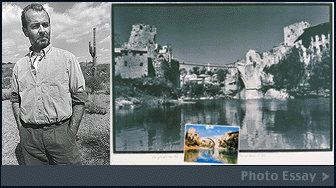|
|
|
The
soldiers I photographed didn’t see me as a foreigner or a journalist,
but as part of themselves. The quality of the portraits in the series
"Portret Bezimene Raje" (Portrait of Nameless Folk),
for example, is affected by the fact that I lived with those people
as a fellow participant in the war, experiencing harsh weather,
lack of food, sleepless nights. So perhaps I’ve created more
sincere portraits, more truthful ones than those taken by photographers
who were simple visitors to the war.
|
 |
I
have captured the life of a warrior, the psychology of a fighter,
genuine, unposed. They are family portraits taken by a family member
– not a professional hired by the family. Yes, these are my people,
men that I was in the war with. During the war I cried over people
whose names I didn’t even know, but with whom I shared everything
while on the front lines, marching in columns. These people become
your brothers and fathers and sisters and mothers and children, everything.
My photographs, especially the ones from 1994 and 1995, are made by
a man who lived through the war. The foreign photographers never felt
it, nor could they ever feel it. They will never be in my skin, nor
I in theirs. It’s possible that they could have taken photographs
like mine, but they were simply not interested in that because it
wasn’t their goal. That’s the difference: they photographed
their assignments, and I lived the life they were photographing. I
was on the inside, they were on the outside. It’s a crucial difference.
In the beginning of the war, I wasn’t coping very well. I couldn’t
behave like an artist, even though I was taking photographs. At first
I was just a man defending his family and neighbors – that’s
where my feelings were. For the first two years, it seemed so temporary.
I just accepted the situation and my first priority was survival-
for my kids, my family, myself, and my city. But after a while, you
get used to it and can start to behave more like a human being. At
the end of 1993, I assigned myself the task of thinking seriously
about what was happening in the city, in Bosnia, and in my life, and
to start reacting to it as an artist. It was a conscious decision,
though I had to wait until I felt it and started to see things through
different eyes- until I was ripe for it. I started to notice things
I hadn’t been able to see before. I wanted to capture the mood,
the atmosphere of those times. I sought out days when the streets
were wet, moments of emptiness. Yet reflected in these lifeless streets,
you catch a gleam of light, of optimism. You’ll also find in
the foreground these sewer manhole covers, which point to the neverworld.
The dark side and the optimism exist in accordance. That was the rift
in which Sarajevo existed at the time. Sarajevo lived, and yet there
was no life… In a sense, it was through the war that I started
acting as a real artist. I wasn’t working except for my volunteer
duties with the army; there was no other business and I could devote
myself, my whole life, to my art. And even today, photography is still
the most important thing to me. The war deprived me of certain things;
I was wounded, I lost a great number of friends- known and unknown-
but I discovered a certain freedom through it, too. My freedom before
the war came from a sense of financial and social security. During
the war I had to give up money. I was free from any kind of commercial
work associated with photography and thought solely in artistic terms…
Today, I feel that I’m a happy man. These photographs sometimes
seem like a fragment of a dream.
Phoenix, Arizona
March 8, 2000 |
 |
|
